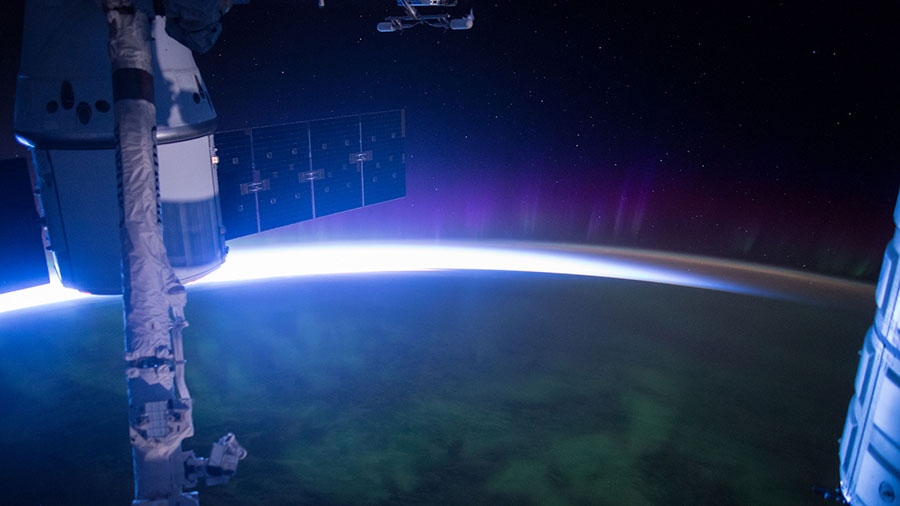 |
| Africa and the Mediterranean Sea, under a full moon. Just another enchanted evening in orbit. (Image courtesy Tim Peake / ESA.int.) |
It's hard enough running a marathon in full gravity, but how about in micro-g? Well, with a proper harness, a live TV feed of the runners, and a whole planetful of motivation, it was a job that ESA astronaut Tim Peake completed last Sunday. The endeavor was not only a great athletic feat, but also provided data for the Energy experiment, which seeks to better understand what "fuel" astronauts must consume to offer them optimum energy for performing their space missions.
Peake ran the London Marathon on the ISS's exercise treadmill while in sync with his fellow earthlings via the RunSocial app and a live video feed, which he said was "extremely motivating." You can read his blog on the experience here. He completed the race in 3 hours, 35 minutes...enough time for the station itself to take about two full laps of the planet!
| Staying well-hydrated thanks to an array of water pouches, Peake weathered his tethers to finish the London Marathon in record time. (Image courtesy collectspace.com.) |
Previously, NASA astronaut Sunita Williams had run the Boston Marathon in a similar fashion aboard the ISS, completing the race from space in 2007. However, Peake's time for the 26.2-mile London Marathon was good enough to earn him the Guinness World Record for fastest space marathon ever. Well done, Astronaut Peake!
In other news, this week the ISS crew prepped to send the SpaceX Dragon back home. Experiments, gear, hardware, and other cargo will be returned when the Dragon splashes down on May 11th. Unlike some other spacecraft, the Dragon is not designed to burn up upon reentry, and can safely deliver its scientific payload to Earthly engineers.
 |
| That's the Dragon there on the left, breathing the "fire" of a space sunrise. (Image courtesy NASA.gov.) |
The astronauts also worked on a variety of science experiments, including assessing Earth's forest coverage from space using hyperspectral and infrared equipment, and obtaining a better understanding of emissions interactions with the atmosphere during dynamic trips to orbit. A Filipino microsatellite was launched from Japan's Kibo module, with a mission of monitoring Earth's climate for potential weather troubles.
 |
| The DIWATA-1 ("Fairy") satellite is set to help monitor conditions surrounding natural disaster response time, among other things. (Image courtesy NASA.gov.) |
Speaking of watching things from an orbital perspective, the film "A Beautiful Planet", shot entirely on 4K video from the vantage point of the ISS, debuted this week. It includes amazing imagery captured by the astronauts as well as the time-lapse results of long-exposure footage from outside the station. Earth's aurora, weather patterns, terrain features, astronaut routines, and more are showcased in spectacular form...and you can see it all in IMAX 3D! It's almost as good as being stationed up there yourself (sorry, they can't mimic the micro-gravity in theaters...yet.)
Check out what the astronauts involved had to say about
"A Beautiful Planet."
Want to see what the station spots in real-time? Use this live ISS HD feed to constantly spy on our beautiful blue marble. Sure, sometimes it dark, but sometimes its glorious...just like our existences down here.
Since the Earth can't take selfies, NASA astronaut Jeff Williams has been doing the honor. Here's how good we looked this week...
 |
| Namibian sand dunes, including one called "Big Daddy." |
 |
| A fantastic fish-shaped landmass and reef in the Bahamas... |
 |
| ...and one glorious glacier. |
That's all for this week, space fans! We hope to entertain and educate even more Earthlings next time...watch this space!
 |
| "Caught Mt. Etna having a cheeky smoke yesterday!" -Tim Peake Stay healthy, Earthlings, and maybe someday you too can set sports records IN SPACE! (Image courtesy Tim Peake / ESA.int.) |

No comments:
Post a Comment